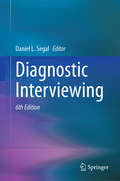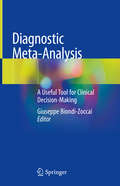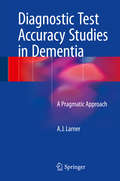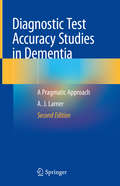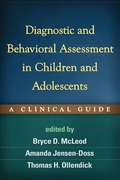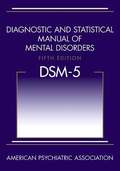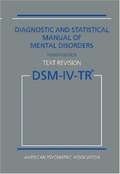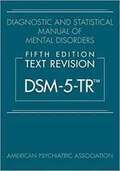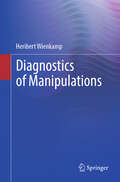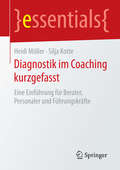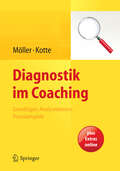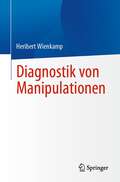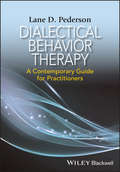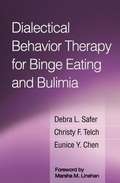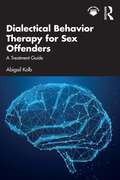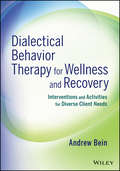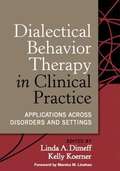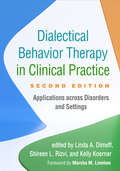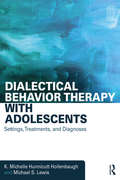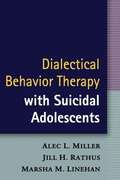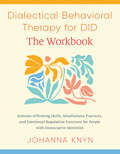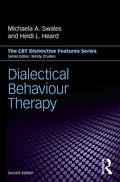- Table View
- List View
Diagnostic Interviewing
by Daniel L. SegalA cornerstone of the professional therapeutic relationship and a vital prerequisite to effective treatment, the diagnostic interview sets the tone for interventions that follow. This welcome update to the authoritative textbook includes coverage of foundational and advanced skills and strategies for effective clinical and diagnostic interviewing. Completely revised and updated to correspond to the DSM-5-TR and to reflect the latest innovations in theory and evidence-based practice, this instructive book offers a wealth of useful interviewing strategies and techniques. Specific interviewing approaches are discussed for diverse settings and diverse clients across a variety of presenting problems and mental disorders, as well as keys to ensuring that the interview process is effective and clinically sound. As with its predecessors, this volume emphasizes the value of the interview as the foundation for treatment planning, intervention, and the healing therapeutic relationship. Among the topics covered: Ethical and professional issues. Interviewing strategies, rapport, and empathy. Presenting problem, history of presenting problem, and social history. The mental status examination. Consideration of neuropsychological factors in interviewing. Specific disorders including depressive disorders, bipolar disorders, anxiety disorders, obsessive-compulsive and related disorders, trauma and stressor-related disorders, dissociative disorders, somatic symptom disorders, eating disorders, sexual dysfunctions and gender dysphoria, substance use disorders, personality disorders, and schizophrenia spectrum disorders. Special populations, including children, older adults, interviewing in health, medical, and integrated care settings, and interviewing individuals at risk for suicide. Previous editions of Diagnostic Interviewing have been used in the training and education of diverse mental health professionals including psychologists, psychiatrists, social workers, marriage and family therapists, and professional counsellors. This Sixth Edition will continue this tradition, aiding students, new practitioners, and seasoned clinicians.
Diagnostic Meta-Analysis: A Useful Tool for Clinical Decision-Making
by Giuseppe Biondi-ZoccaiThis book is the first exclusively devoted to the systematic synthesis of diagnostic test accuracy studies. It builds upon the major recent developments in reporting standards, search methods, and, in particular, statistical tools specifically devoted to diagnostic studies. In addition, it borrows extensively from the latest advances in systematic reviews and meta-analyses of intervention studies. After a section dedicated to methods for designing reviews, synthesizing evidence and appraising inconsistency in research, the application of these approaches is demonstrated in the context of case studies from various clinical disciplines. Diagnosis is central in medical decision-making, and in many other fields of human endeavor, such as education and psychology. The plurality of sources of evidence on diagnostic test accuracy poses a huge challenge for practitioners and researchers, as do the multiple dimensions of evidence validity, which include sensitivity, specificity, predictive values, and likelihood ratios. This book offers an invaluable resource for anyone aiming to improve decision-making processes in diagnosis, classification or risk prognostication, from epidemiologists to biostatisticians, radiologists, laboratory physicians and graduate students, as any physician interested in refining his methodological skills in clinical diagnosis.
Diagnostic Test Accuracy Studies in Dementia
by A. J. LarnerThis book explains the key steps in planning and executing diagnostic test accuracy studies in dementia, with clear explanations of difficulties and pitfalls and with jargon clearly explained. The emphasis is on pragmatic diagnostic test accuracy studies which can be integrated into day-to-day clinical practice. The book is based on the author's experience over more than 10 years, which has resulted in the publication of many diagnostic test accuracy studies. The text is structured as for a research publication on a diagnostic test accuracy study (Introduction, Methods, Results, Discussion), with a final chapter on Future Prospects. Each of the chapters is devoted to a practical and structured overview of each of these steps in performing and writing up such a study. Diagnostic Test Accuracy Studies in Dementia: A Pragmatic Approach is aimed at any clinician with an interest in dementia disorders: old age psychiatrists, geriatricians, neurologists, neuropsychologists and primary care physicians, as well as other professions allied to medicine. The book is also of interest to any clinician/researcher with an interest in diagnostic test accuracy studies.
Diagnostic Test Accuracy Studies in Dementia: A Pragmatic Approach
by A. J. LarnerThe new and updated edition of this book explains the key steps in planning and executing diagnostic test accuracy studies in dementia, serving as an introduction to the topic with clear explanations of difficulties and pitfalls. It has been fully revised in light of developments over the past 5 years and includes STARD publications which have appeared since the first edition as well as the use of biomarkers of cognitive disorders as increasingly enshrined in diagnostic criteria. The book covers the presentation of study results in terms of measures of discrimination, taking examples from studies in dementia looking at various diagnostic methods including cognitive instruments, neuroimaging, and biochemical studies. The book continues to reflect the author’s own experience in diagnostic test accuracy studies, particularly in the sphere of cognitive screening instruments..Diagnostic Test Accuracy Studies in Dementia encourages clinicians to adopt a pragmatic approach to diagnostic test accuracy studies rooted in day-to-day clinical practice.
Diagnostic and Behavioral Assessment in Children and Adolescents
by Thomas H. Ollendick Amanda Jensen-Doss Bryce D. McleodThis comprehensive volume shows how to use both diagnostic and behavioral assessment knowledgeably and effectively throughout the process of treatment. The two traditions have developed along separate paths--each with its own conceptual underpinnings and psychometric strengths. Used together, they can produce a complete picture of a child's or adolescent's needs and strengths. The expert editors and contributors describe the full range of evidence-based assessment tools and illustrate their application with two intake-to-termination case examples, both based on DSM-5. Reproducible tools include a behavioral recording form and a multipage case conceptualization worksheet that can be downloaded and printed in a convenient 8 1/2" x 11" size.
Diagnostic and Statistical Manual of Mental Disorders, (DSM-5), 5th edition
by American Psychiatric AssociationThis new edition of Diagnostic and Statistical Manual of Mental Disorders (DSM-5®), used by clinicians and researchers to diagnose and classify mental disorders, is the product of more than 10 years of effort by hundreds of international experts in all aspects of mental health. Their dedication and hard work have yielded an authoritative volume that defines and classifies mental disorders in order to improve diagnoses, treatment, and research. The criteria are concise and explicit, intended to facilitate an objective assessment of symptom presentations in a variety of clinical settings -- inpatient, outpatient, partial hospital, consultation-liaison, clinical, private practice, and primary care. New features and enhancements make DSM-5® easier to use across all settings: • The chapter organization reflects a lifespan approach, with disorders typically diagnosed in childhood (such as neurodevelopmental disorders) at the beginning of the manual, and those more typical of older adults (such as neurocognitive disorders) placed at the end. Also included are age-related factors specific to diagnosis. • The latest findings in neuroimaging and genetics have been integrated into each disorder along with gender and cultural considerations. • The revised organizational structure recognizes symptoms that span multiple diagnostic categories, providing new clinical insight in diagnosis. • Specific criteria have been streamlined, consolidated, or clarified to be consistent with clinical practice (including the consolidation of autism disorder, Asperger's syndrome, and pervasive developmental disorder into autism spectrum disorder; the streamlined classification of bipolar and depressive disorders; the restructuring of substance use disorders for consistency and clarity; and the enhanced specificity for major and mild neurocognitive disorders). • Dimensional assessments for research and validation of clinical results have been provided. • Both ICD-9-CM and ICD-10-CM codes are included for each disorder, and the organizational structure is consistent with the new ICD-11 in development. The Diagnostic and Statistical Manual of Mental Disorders, Fifth Edition, is the most comprehensive, current, and critical resource for clinical practice available to today's mental health clinicians and researchers of all orientations. The information contained in the manual is also valuable to other physicians and health professionals, including psychologists, counselors, nurses, and occupational and rehabilitation therapists, as well as social workers and forensic and legal specialists.
Diagnostic and Statistical Manual of Mental Disorders, (DSM-IV), 4th edition
by American Psychiatric AssociationSince the DSM-IV was published in 1994, we've seen many advances in our knowledge of psychiatric illness. This Text Revision incorporates information culled from a comprehensive literature review of research about mental disorders published since DSM-IV was completed in 1994. Updated information is included about the associated features, culture, age, and gender features, prevalence, course, and familial pattern of mental disorders. The DSM-IV-TR brings this essential diagnostic tool up-to-date, to promote effective diagnosis, treatment, and quality of care. Now you can get all the essential diagnostic information you rely on from the DSM-IV along with important updates not found in the 1994 edition. Stay current with important updates to DSM-IV-TR TM. Benefit from new research into Schizophrenia, Asperger's Disorder, and other conditions Utilize additional information about the epidemiology and other facets of DSM conditions Update ICD-9-CM codes implemented since 1994 (including Conduct,Disorder, Dementia, Somatoform Disorders) Sections on prevalence, gender/age/culture, course, and familial pattern have also been revised to reflect recent research findings. More comprehensive differential diagnoses have been incorporated for many of the disorders.
Diagnostic and Statistical Manual of Mental Disorders, Text Revision (DSM-5-TR)
by American Psychiatric AssociationThe Diagnostic and Statistical Manual of Mental Disorders, Fifth Edition, Text Revision (DSM-5-TR), is the most comprehensive, current, and critical resource for clinical practice available to today's mental health clinicians and researchers. <p><p>DSM-5-TR includes the fully revised text and references, updated diagnostic criteria and ICD-10-CM codes since DSM-5 was published in 2013. It features a new disorder, Prolonged Grief Disorder, as well as codes for suicidal behavior available to all clinicians of any discipline without the requirement of any other diagnosis. <p><p>With contributions from over 200 subject matter experts, this updated volume boasts the most current text updates based on the scientific literature. Now in four-color and with the ability to authenticate each printed copy, DSM-5-TR provides a cohesive, updated presentation of criteria, diagnostic codes, and text. <p><p>This latest volume offers a common language for clinicians involved in the diagnosis and study of mental disorders and facilitates an objective assessment of symptom presentations across a variety of clinical settings—inpatient, outpatient, partial hospital, consultation-liaison, clinical, private practice, and primary care. <p><p>Stay current with these important updates in DSM-5-TR: • Fully revised text for each disorder with updated sections on associated features, prevalence, development and course, risk and prognostic factors, culture, diagnostic markers, suicide, differential diagnosis, and more.• Addition of Prolonged Grief Disorder (PGD) to Section II—a new disorder for diagnosis• Over 70 modified criteria sets with helpful clarifications since publication of DSM-5• Fully updated Introduction and Use of the Manual to guide usage and provide context for important terminology• Considerations of the impact of racism and discrimination on mental disorders integrated into the text• New codes to flag and monitor suicidal behavior, available to all clinicians of any discipline and without the requirement of any other diagnosis• Fully updated ICD-10-CM codes implemented since 2013, including over 50 coding updates new to DSM-5-TR for substance intoxication and withdrawal and other disorders• Updated and redesigned Diagnostic Classification <p><p>This manual is a valuable resource for other physicians and health professionals, including psychologists, counselors, nurses, and occupational and rehabilitation therapists, as well as social workers and forensic and legal specialists. The new DSM-5-TR is the most definitive resource for the diagnosis and classification of mental disorders.
Diagnostics of Manipulations
by Heribert WienkampManipulations are encountered "at every turn" and in countless everyday situations. If this is the case, the (early) recognition of manipulations takes absolute precedence. This is especially true for specialists regarding their diagnostics and analysis. In everything that is presented and offered in verbal expressions, the tentative differentiation between fiction and truth is the focus of the events. Because only a reasonably complete and truthful outline of the problem contains the potential for gaining insight or uncovering lies or half-truths. Lies, deceptions, excuses, etc., are manipulative activities or reactions that are intended to create a different, namely consciously false impression. However, manipulative maneuvers can be observed and require further investigation not only in interpersonal situations but also in larger social contexts or systems, for example, to successfully play games like chess or to solve problems through regulations accepted by all. This publication could particularly benefit the following target groups: executives, HR experts in academia and practice, and specialists who need to assess the credibility of statements based on "fiction and truth" or who are involved in other support mandates.
Diagnostik im Coaching kurzgefasst: Eine Einführung für Berater, Personaler und Führungskräfte (essentials)
by Heidi Möller Silja KotteDieses essential erläutert zunächst den Begriff der ,,Diagnostik" im Rahmen von Coaching und diskutiert die Notwendigkeit einer systematischen Eingangsdiagnostik. Die Autorinnen nennen die Unterschiede, die es beim diagnostischen Vorgehen im Coaching je nach theoretischer Perspektive oder ,,Coachingschule" gibt, und erörtern schulenspezifische Besonderheiten. In der Coachingdiagnostik müssen über die individuelle Ebene hinaus auch die Ebenen Rolle, Team und Organisation des Coachee berücksichtigt werden. Für diese verschiedenen Ebenen werden beispielhaft jeweils konkrete diagnostische Verfahren dargestellt. Heidi Möller und Silja Kotte stellen zudem eine Systematik zur Einordnung des diagnostischen Vorgehens im Coaching vor (Kasseler Coaching Inventar) und geben Praktikern eine Systematik für das Erstgespräch (Kasseler Coaching Raster) an die Hand.
Diagnostik im Coaching: Grundlagen, Analyseebenen, Praxisbeispiele
by Heidi Möller and Silja KotteDer Erfolg von Coaching – also der berufsbezogenen Einzelberatung von Führungskräften, Verantwortungsträgern und Selbständigen – hängt nicht nur vom Einsatz geeigneter Coaching-Tools, der Beratungskompetenz des Coaches etc. ab. – Für ein erfolgreiches Coaching ist es mindestens ebenso wichtig, zu Beginn des Prozesses die Ausgangssituation und Ziele des Klienten, seines Teams sowie der gesamten Organisation „sauber“ zu erfassen. Diagnostische Kompetenz und die Durchführung einer systematischen Diagnostik werden heute als zentrale Wirkfaktoren im Coaching benannt.Dieser Sammelband mit Beiträgen anerkannter Experten bietet erstmals eine systematische Darstellung diagnostischer Zugänge und Analyse-Ebenen im Coaching: Neben diagnostischen Ansätzen unterschiedlicher theoretischer Hintergründe (u.a. psychometrische, projektive, kreative, verhaltensorientierte) werden relevante Analyseebenen (Person, Rolle, Team, Organisation) erläutert sowie konkrete Verfahren vorgestellt. Der Band endet mit einer zusammenfassenden Systematisierung. – Wissenschaftlich fundiert und doch nah an den Anforderungen der Praxis – durch Checklisten und Fallbeispiele.Dieses Buch ist eine grundsätzliche Bereicherung für den Wissensschatz von Coaches, Beratern und Trainern: Stellen Sie Ihren Coaching-Prozess auf ein solides Fundament – entwickeln Sie Ihre diagnostische Kompetenz!
Diagnostik von Manipulationen
by Heribert WienkampManipulationen begegnen uns auf „Schritt und Tritt“ und in unzähligen alltäglichen Situationen. Wenn dem so ist, hat das (frühzeitige) Erkennen von Manipulationen absoluten Vorrang.Dies gilt erst recht bei Fachexperten bezüglich ihrer Diagnostik und Analyse. Bei allem, was an verbalen Äußerungen aufgetischt und angeboten wird, steht die versuchsweise Differenzierung zwischen Dichtung und Wahrheit im Focus des Geschehens. Denn nur eine einigermaßen vollständige und wahrheitsgetreue Problemskizze birgt das Potenzial zur Erkenntnisgewinnung bzw. zur Entlarvung von Lügen oder Halbwahrheiten. Lügen, Täuschungen, Ausreden usw. sind manipulative Aktivitäten oder Reaktionen, die einen anderen, nämlich bewusst falschen Eindruck erzeugen sollen. Aber nicht nur in interpersonellen Situationen, sondern auch in größeren sozialen Zusammenhängen oder Systemen sind manipulative Manöver festzustellen und genauer zu erforschen, um z.B. Spiele wie das Schachspiel erfolgreich zu absolvieren oder Probleme durch von allen akzeptierte Regelungen zu lösen.Von dieser Publikation könnten als Zielgruppen besonders profitieren: Führungskräfte, Personalexperten in Wissenschaft und Praxis und Spezialisten, die entweder die Glaubwürdigkeit von Aussagen auf „Dichtung und Wahrheit“ zu beurteilen haben oder sonstigen Betreuungsmandaten nachgehen.
Diagnostik: Eine Einführung (Module Erziehungswissenschaft #5)
by Erwin BreitenbachDas Buch liefert Basiswissen, das Studierende mit soliden und umfassenden diagnostischen Kompetenzen für den künftigen Unterrichtsalltag in der Schule ausstattet. Neben Konzepten und Begriffen zur Evaluation des Lehrens – Lernverlaufsdiagnostik, werden verschiedene Methoden erläutert, mit denen nicht erwartungsgemäße Lernverläufe analysiert werden können. Gezielt werden Curriculum nahe und im Unterricht leicht einsetzbare Verfahren gezeigt, die den Erfordernissen inklusiven Unterrichtens entsprechen.Der InhaltTheoretische Grundlegungen von Diagnostik • Lernverlaufsdiagnostik • Förderdiagnostik • Fallbeispiel zur Förderdiagnostik • Aktueller Forschungsstand zur pädagogischen DiagnostikDer AutorDr. Erwin Breitenbach ist Professor für Rehabilitationspsychologie an der Humboldt Universität zu Berlin.
Dial Down the Drama: Reducing Conflict and Reconnecting with Your Teenage Daughter¿A Guide for Mothers Everywhere
by Colleen O'GradyTeen daughters are on an emotional rollercoaster, and responding in kind adds fuel to the fire. It&’s important for moms to be a stable anchor during this stage in their life.Family therapist and mom Colleen O&’Grady shares what she learned firsthand during her own daughter&’s teenage years about how best to calmly de-escalate even the most stressful scenes and parent intentionally even when your teen is pushing you away.In Dial Down the Drama, O&’Grady shows every mom how to learn to:Regain perspectiveBreak the cycle of conflictTune into her daughter without drowning in the dramaFoster spontaneous conversationsReplace worrying and overreacting with effective communication and actionAnd much more!Moodiness, anger, and defiance can stress the best of us. This empowering guide gives you the tools you need to defuse the drama - and dial up the joy.As Colleen has said, you don&’t dial down the drama in order to survive the teenage years; you do so because you actually can enjoy them! Dial Down the Drama provides the tools you need to do just that.
Dialectical Behavior Therapy
by Lane D. PedersonA definitive new text for understanding and applying Dialectical Behavior Therapy (DBT). Offers evidence-based yet flexible approaches to integrating DBT into practice Goes beyond adherence to standard DBT and diagnosis-based treatment of individuals Emphasizes positivity and the importance of the client's own voice in assessing change Discusses methods of monitoring outcomes in practice and making them clinically relevant Lane Pederson is a leader in the drive to integrate DBT with other therapeutic approaches
Dialectical Behavior Therapy for Binge Eating and Bulimia
by Christy Telch Debra SaferThis groundbreaking book gives clinicians a new set of tools for helping people overcome binge-eating disorder and bulimia. It presents an adaptation of dialectical behavior therapy (DBT) developed expressly for this population. The treatment is unique in approaching disordered eating as a problem of emotional dysregulation. Featuring vivid case examples and 32 reproducibles, the book shows how to put an end to binge eating and purging by teaching clients more adaptive ways to manage painful emotions. Step-by-step guidelines are provided for implementing DBT skills training in mindfulness, emotion regulation, and distress tolerance, including a specially tailored skill, mindful eating.
Dialectical Behavior Therapy for Binge Eating and Bulimia
by Marsha M. Linehan MD Debra L. Safer PhD Christy F. Telch PhD Eunice Y. ChenThis groundbreaking book gives clinicians a new set of tools for helping people overcome binge-eating disorder and bulimia. It presents an adaptation of dialectical behavior therapy (DBT) developed expressly for this population. The treatment is unique in approaching disordered eating as a problem of emotional dysregulation. Featuring vivid case examples and 32 reproducible handouts and forms, the book shows how to put an end to binge eating and purging by teaching clients more adaptive ways to manage painful emotions. Step-by-step guidelines are provided for implementing DBT skills training in mindfulness, emotion regulation, and distress tolerance, including a specially tailored skill, mindful eating. Purchasers get access to a Web page where they can download and print the reproducible handouts and forms in a convenient 8 1/2" x 11" size.
Dialectical Behavior Therapy for Sex Offenders: A Treatment Guide
by Abigail KolbThis treatment guide allows clinicians to effectively integrate dialectical behavior therapy (DBT) as a psychological treatment with men who have committed sexually motivated offenses.It provides clinicians with the most current, evidence-based research about sex offenders' risks and treatment needs, and draws upon the therapeutic techniques of DBT and cognitive behavioural therapy. This guide is divided into five parts that provide practical, evidence-based skills for clients to apply to their lives and reduce their likelihood of recidivism. It explores numerous skill sets that target all major areas of dysregulation commonly seen among men who have committed sexual offences. Worksheets, images, group discussion ideas, and role-play scenarios are used throughout to help clients practice their skills within the group setting and on their own.This guide is essential for all mental health professionals who work with men who have committed sexual crimes.
Dialectical Behavior Therapy for Wellness and Recovery
by Andrew BeinThis hands-on guide addresses the present day realities of applying dialectical behavior therapy in a mental health and substance abuse recovery context. The book presents the DBT concept, Wise Mind, as adapted by author Andrew Bein, as central to a simple, powerful, empirically supported framework that respectfully engages clients in their own efforts to enhance personal well-being. The book includes empirically supported exercises with an emphasis on collaboration and client empowerment using a recovery oriented model for client treatment and improved outcomes.
Dialectical Behavior Therapy in Clinical Practice
by Kelly Koerner Linda DimeffFirst developed to treat suicidal individuals with borderline personality disorder, dialectical behavior therapy (DBT) has since been adapted to a range of settings and populations. This practical book--edited by close collaborators of DBT originator Marsha M. Linehan--presents applications for depression, substance dependence, eating disorders, psychosis, suicidal and assaultive behaviors, and other complex problems. Leading contributors, including Linehan herself, describe how to implement this evidence-based treatment with adults, adolescents, couples and families, and forensic clients. Issues in establishing and maintaining an effective DBT program are also addressed. Special features include over a dozen reproducible worksheets and forms, which book buyers can also download and print from Guilford's website.
Dialectical Behavior Therapy in Clinical Practice, Second Edition: Applications across Disorders and Settings
by Linda A. Dimeff Marsha M. Linehan Kelly Koerner Shireen L. RizviThis influential work has now been substantially revised with over 60% new material reflecting over a dozen years of research and clinical advances. Leading experts describe innovative ways to use dialectical behavior therapy (DBT) in a wide range of real-world clinical and community settings. The volume provides wise guidance on setting up, running, and evaluating a comprehensive DBT program. It also presents adaptations designed to meet the needs of particular client populations as time- and cost-effectively as possible. Vivid case examples illustrate diverse applications of DBT for helping adults, adolescents, and children reduce suicidal and self-harming behavior; overcome complex, multiple challenges; and build a life worth living. New to This Edition *Presents current best practices for making DBT more efficient and accessible while maximizing program fidelity. *Chapters on additional populations, including persons with posttraumatic stress disorder and preadolescent children. *Chapters on additional settings, including milieu-based programs, university counseling centers, and middle and high schools. *Chapters on pharmacotherapy, promoting employment and self-sufficiency, training and supervision, and DBT beyond Stage 1. See also Doing Dialectical Behavior Therapy: A Practical Guide, by Kelly Koerner, which demonstrates DBT techniques in detail.
Dialectical Behavior Therapy with Adolescents: Settings, Treatments, and Diagnoses
by K. Michelle Hunnicutt Hollenbaugh Michael S. LewisDialectical Behavior Therapy with Adolescents is an essential, user-friendly guide for clinicians who wish to implement DBT for adolescents into their practices. The authors draw on current literature on DBT adaptation to provide detailed descriptions and sample group-therapy formats for a variety of circumstances. Each chapter includes material to help clinicians adapt DBT for specific clinical situations (including outpatient, inpatient, partial hospitalization, school, and juvenile-detention settings) and diagnoses (such as substance use, eating disorders, and behavioral disorders). The book’s final section contains additional resources and handouts to allow clinicians to customize their treatment strategies.
Dialectical Behavior Therapy with Suicidal Adolescents
by Alec Miller Jill RathusFilling a tremendous need, this highly practical book adapts the proven techniques of dialectical behavior therapy (DBT) to treatment of multiproblem adolescents at highest risk for suicidal behavior and self-injury. The authors are master clinicians who take the reader step by step through understanding and assessing severe emotional dysregulation in teens and implementing individual, family, and group-based interventions. Insightful guidance on everything from orientation to termination is enlivened by case illustrations and sample dialogues. Appendices feature 30 mindfulness exercises as well as lecture notes and 12 reproducible handouts for "Walking the Middle Path," a completely new DBT skills training module for adolescents and their families.
Dialectical Behavioral Therapy for DID--The Workbook: System-Affirming Skills, Mindfulness Practices, and Emotional Regulation Exercises for People with Dissociative Identities
by Johanna KnynEmpowering DBT skills for grounding, emotional regulation, values-guided action, and interpersonal effectivenessDialectical Behavioral Therapy for DID—The Workbook is an empowering guide and an invitation to explore what living well with dissociative identities means to you—at your own pace, and on your own terms.This workbook has been intentionally created to honor all your parts—and embrace your multiplicity. Its goal isn&’t to deny or stifle your identities: It welcomes you as you are, teaching you to trust your internal community and build radical acceptance. This workbook is designed to support your journey toward wellness, however you define that for yourselves.The workbook includes 4 modules:• Grounding Skills offers foundational tools to help you connect with the present moment, mindfully relate to body-based experiences like pain andillness, and honor your internal experience with radical acceptance.• Emotional Regulation Skills includes exercises to help you understand your emotions and make sense of your feelings.• Values-Guided Action Skills helps you identify your values and take committed action in alignment with those values.• Interpersonal Effectiveness Skills gives you tools for communicating with others, setting boundaries, and developing your internal relationships.With gentle check-ins, mindful activity breaks, and bonus exercises like &“Difficult Emotions Decisions Tree&” and &“Pain, Damage, Illness&” mapping, this workbook is grounded in care, compassion, and consent. It offers overviews of key concepts like the &“Window of Tolerance&” and &“Safe-Enough versus Safe,&” inviting you to build supportive containers for your DBT skills. It also provides guidance and checklists to help you create a comfortable environment that accommodates different sensory needs as you embark on your journey through the book.
Dialectical Behaviour Therapy: Distinctive Features (CBT Distinctive Features)
by Heidi L. Heard Michaela A. SwalesDialectical Behaviour Therapy (DBT) is a psychotherapeutic approach used to treat individuals with complex psychological disorders, particularly chronically suicidal individuals with borderline personality disorder (BPD). The therapy articulates a series of principles that effectively guide clinicians in responding to problematic behaviours. Treated problems include, among others, attempting suicide, bingeing, purging, using illegal drugs and behaviours that directly impede the treatment.Dialectical Behaviour Therapy: Distinctive Features highlights theoretical and practical features of the treatment using extensive clinical examples to demonstrate how the theory translates into practice. This updated edition reviews recent modifications to the structure of the treatment and considers more recent research evidence for both the biosocial theory underpinning the treatment and treatment efficacy. The book provides a clear overview of a complex treatment, through a unique application of strategies and a discussion of a comprehensive treatment programme that structures the therapeutic journey for the client.The book will be of interest to clinicians wanting to develop their knowledge about the treatment, prior to formal training; post-graduate students in mental health seeking to learn how to conceptualize complex problems; DBT trained clinicians who require a useful précis of the treatment with clinical examples, and clients about to embark upon this treatment. This book provides a clear and structured overview of a complex treatment. It is written for both practising clinicians and students wishing to learn more about DBT and how it differs from the other cognitive behaviour therapies.
